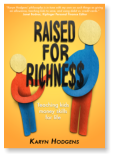I was asked to contribute an article to a book being published on kids and financial literacy (will share more on that later). Apart from being thrilled to have been asked, I happen to love writing, so I jumped at the chance. My given topic was ‘kids and budgeting’ and is a little longer than I usually post. But I think you’ll find it easy to read. Here we go:
~
Nice. You’ve got money. And if you’re like most teens, the first thing that comes to mind is to take that money and spend it. That’s reasonable. After all, you worked hard to get it. You did work hard to get it, didn’t you? But before you call all your friends and set up a date with the mall, ask yourself one question. Do I want to think like a millionaire or do I want to think like someone who lives with mom and dad when they’re 30?
You’re pretty savvy, so my guess is that you chose to think like a millionaire. Good. Because you’re going to learn some important stuff that will allow you to build wealth so that you can have and do the things you want. But always keep one thing in mind. Being rich in money is nice, but it’s also important to be rich in friends, compassion, knowledge, generosity… Then, being rich in money is so much more meaningful, for you and others.
Okay, we’ve got priorities straightened out. Now let’s get to the thinking-like-a-millionaire part. Most millionaires become millionaires because they are savvy in the art of managing their money. And the first thing millionaires do when they manage their money is to pay themselves first. It seems like a silly thing to do since the money is already theirs, but paying themselves, or in this case, yourself, first simply means that you are going to take some of your money and sock it away into savings. Then leave it there. No touchy the money. You’ll see why this is important in a minute. So decide, right now, how much of your money you will put into savings each month. A lot of millionaires started by putting aside 10% of their income. But you decide what works for you right now. You can always add more later.
Okay, pay myself first. Check.
Next, it’s always a good idea to share a little of what we have. Some like to give to their church, others like to donate to causes that are near and dear to their hearts. Whatever you choose, decide how much you want to give and how often you will be giving. It’s often easiest if you do it monthly, similar to how you put money into savings. And, hey, your parents may even be willing to match your donating dollars. They like it when they see you doing things to help others. So ask them.
But does that mean that you have to give money? No. Giving of your time and energy is just as valuable. At some point, though, maybe when you’re earning just a little bit more, you’ll want to re-visit this and make a commitment. Either way, you’ll discover a very important thing. Sharing makes people happy. And being happy is contagious. So share. It’ll make the world a better place.
Share time or money. Check.
Now, since you are a millionaire-in-the-making, you need to figure out where your money is coming from and where it is going. In other words, you’re going to track your income (money in) and expenses (money out). It’s going to take one month to gather enough information to be able to see patterns in your habits, so grab a notebook, use KidsSave or print out a recording sheet by visiting here and start recording. Every single penny you spend or bring in gets recorded. Yes, I know, it’s a hassle. But it needs to be done. Think: millionaire.
Then, when you have one month’s worth of data, look for patterns in your spending habits. If you like, you can create categories using colored pencils. (If you used KidsSave, print out your registry.) Items like soda, chips, and gum would go in a ‘snack’ category and can all be colored, say, yellow. Video games, itunes, and that new Wii controller you just bought would go in an ‘electronics’ category and colored…red. You get the idea. Expenses that are the same each month like your cell phone bill, remain in their own category. They are fixed expenses. And remember your charity and automatic savings? Consider those fixed expenses, as well.
Add up the totals for each of your expense categories. Then add up all the categories in expenses. That’s about how much you spend each month. Next, add up all the categories in income. That’s about how much you bring in each month. Subtract expenses from income. That’s how much money you have left over. No, duh. Want more money left over? Keep reading.
Keep track of my income and expenses. Check.
Okay, so you’re interested in ending up with more money. The good news is, it’s not that hard to do. And it can make a huge difference in whether or not you reach millionaire status and how quickly you get there. Here’s how.
Go grab that list of expenses you carefully recorded for one month; it’s time to take another look. This is where it can get interesting, so hang on. Choose one of the categories, like electronics, and look at the total amount you spent during that month. Now multiply that number by 12. That’s about how much you can expect to spend on electronics for the entire year. Do that with the other expense categories. Pretty eye-opening, huh? Time to reduce spending?
Start by taking a real close look at all the things you spent money on. Not happy about blowing a bunch of money on snacks at the mall? Great. Stop doing it. Wish you hadn’t bought those funky sunglasses that you never wear? Then think twice about putting out money for things you don’t really need. Not that you don’t get to have some fun with your money. Treating yourself is important. Just be aware of where your money is being spent. There’s a saying that goes “It’s better to tell your money where to go than to ask it where it’s gone.” So pay attention.
Alright, reduce spending. Check.
Okay, are you sitting down? Because this is the part where I bring up the ‘B’ word. Adults do not like this word. A lot of them even cringe when they hear it. But you’re not afraid. You’re a millionaire-in-the-making which puts you into the tough category.
Deep breath.
Budget.
Budget? Yup, budget…a plan for your money. It’s hard to become a millionaire without one so let’s just hit it straight on. Besides, when you see what’s really involved, you’re going to wonder why so many adults haven’t taken the plunge.
The first thing you need to do is track your income and expenses. Done. Then you need to create income and expense categories. Done. Next, you need to subtract your expenses from your income. Done. OMG! The budget’s done. No kidding. You just need to make sure that you’re meeting all your objectives of saving and spending carefully and that, then, pretty much sums up how to create a budget. Sheesh, what’s up with these adults?
Create budget. Check.
So, when you created your budget you discovered some extra money. Money that was left over after you subtracted your expenses from your income. Beautiful. Now we get to the fun part, the building-wealth-to-become-a-millionaire part. The part where you learn how to make money work FOR YOU, instead of you working for it.
Remember that pay-yourself-first money you’ve been saving? Here’s where it comes into play. You’re going to take that money along with the extra savings you just found in your budget and begin to invest it. But here’s the deal. The money you invest is money that you won’t be able to touch for awhile. I’m talking several years. In fact, the longer you can leave it alone, the better. Let me give you a quick example.
If you started saving $100 every month when you were 18 years old, and you invested it where it received 6% annual interest, by the time you turned 65 you would have $313,187. If you did the same thing but were receiving 10% annual interest, you would end up with $1,281,919. The secret is something called compound interest. Compound interest is money that grows on itself. Remember Einstein? Pretty smart, right? Well Einstein knew how special compound interest is. He called it the greatest force in the universe. Over time small amounts of money become large amounts of money. And if you keep making contributions while not touching any of it, yowza, it’ll take off like a bat out of H – E – double hockey sticks. Sick.
And what should you invest in? Lots of things. The key is to diversify. That’s when you divide your money into different investments. CDs and bonds are a good place to start. I also recommend mutual funds. When you’re ready you can begin investing in individual companies in the stock market. And maybe one day you’ll move on to real estate. But do your research first. Always do your research. http://Www.bankrate.com and http://www.fool.com are great places for that.
Begin my investing portfolio. Check.
Well there you have it. You’ve just set yourself up to become a millionaire. You are in control of your financial future. How cool is that? It’s very cool because that puts you into an elite group of people. A group of people with a millionaire mindset. You’re on your way to great things. Keep focused. Know your goals. Follow your dreams. Go get ‘em!
Filed under: Kids and Budgeting, Kids and Investing, Kids and Saving, Kids and Sharing, Teaching Kids Financial Literacy | Tagged: karyn hodgens, kidnexions, kids allowance, kids and finacial literacy, kids and money, kids money management, teaching kids money | 2 Comments »



